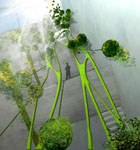LOFT
location
London
size
550,000 square feet
type
mixed-use with vertical farm
entry year
2011
architect
RCDF
When Rogerio Carvalheiro founded RC Design Federation, now RCDF, the 20-year design vet did so with a philosophy based upon the idea of reinterpretive contextualism, meaning “the world will inform all design and, in turn, the design will affect and challenge its surroundings,” he says. Having grown up on a farm in rural Canada, Carvalheiro was intrigued by the idea of hydroponics and how its implementation could allow existing farmlands to be turned back into natural ecosystems. In entering the AWR-sponsored London Farm Tower 2011 competition—where its entry, LOFT, was named a finalist—the RCDF team set out to imagine a world where every city has its own source of local food and where no drop of water or particle of light is wasted.
concept/
LOFT is a hypothetical 550,000-square-foot building near London City Hall and Tower Bridge; its design was based on the theories of The Vertical Farm: Feeding the World in the 21st Century, a book by Columbia University professor Dickson Despommier. “We were keen on interspersing the hydroponics and the residential components so that each inhabitant’s everyday experience within the building would enhance their relationship with food production and nature,” Carvalheiro says. “The inhabitants of our tower would grow food within the protective shell of our building and sell their surplus produce in the on-site market.”
hydroponics/
LOFT integrates closed-loop systems that are essentially man-made ecosystems. These ecosystems intersperse residential spaces, hydroponics, aquaponics, bee sanctuaries, and livestock housing with a vertical park, theaters, classrooms, markets, and restaurants. “Farming is integral to our culture,” Carvalheiro says. “Proposing such a concept could be perceived as radical, but in a world where 100 percent of our agricultural land is already in use, hydroponics could become the only viable means to grow the amounts of food needed to sustain our future global population.

This diagram shows the multitude of activities within the building, including raising livestock.
water/
RCDF made plans to fully integrate a comprehensive rainwater-collection system, a greywater-filtration system, and an on-site waste-treatment center. “We incorporate water turbines powered by the Thames River and wind turbines powered by prevailing winds,” Carvalheiro says. “The entire building program is then interconnected via vines that effectively transport nutrient-rich water for growing, soiled water for filtration, clean water for consumption, and electrical power through their multitubular cores.”
bee sanctuary/
Carvelheiro’s design even attempts to address reports that honey bees are dying at an alarming rate in North America and Europe. “Without bees, humanity would live only four years,” Carvalheiro says. “Nothing can replace what a bee can do. It has been found that bees are thriving in urban areas now more than [in] rural areas given the massive amounts of pesticides used for typical agriculture. Because of this, we dedicated a large portion of our building as a bee sanctuary.”
scale/
Although many countries have begun implementing hydroponic farming, RCDF’s design pushes the scale envelope. Though it may be some time before its ideas can be fully incorporated in an actual building, Carvalheiro is quick to note that LOFT is no pipe dream. “Our building might not have been as conceptual as some of the other entries, given its buildability,” Carvalheiro says. “We chose to explore a design that incorporates cutting-edge technology within a structure that could make an impact today, not just in the future.”
future/
The company is currently talking to the city of West Hollywood about potentially integrating a building like this into the area’s urban fabric. It is also developing a concept called Hydro101, which will propose a double-deck over the 101 Freeway from the Hollywood Bowl to downtown Los Angeles. Hydro101 will integrate a large hydroponics component, a people mover, and an urban park.

